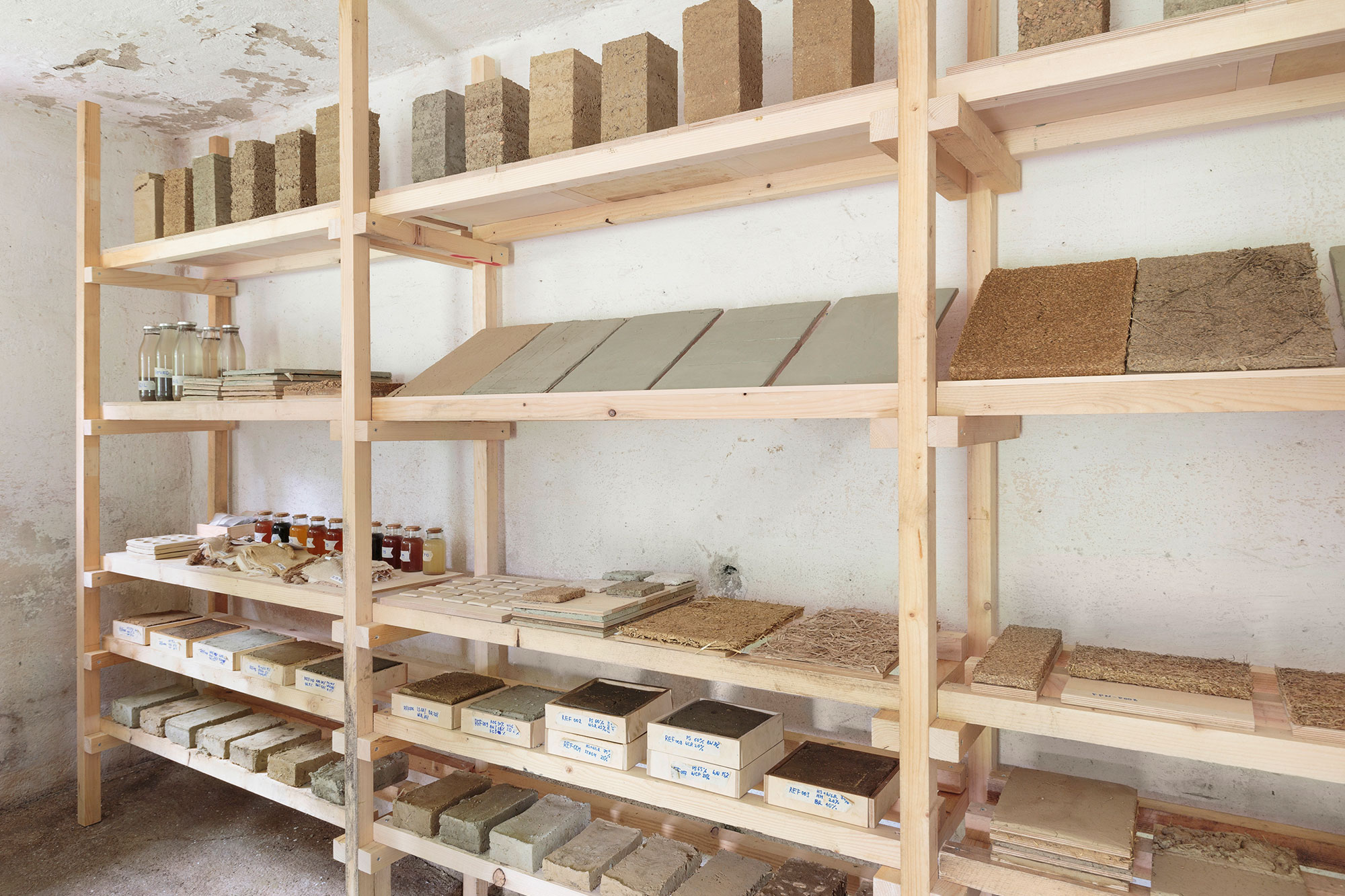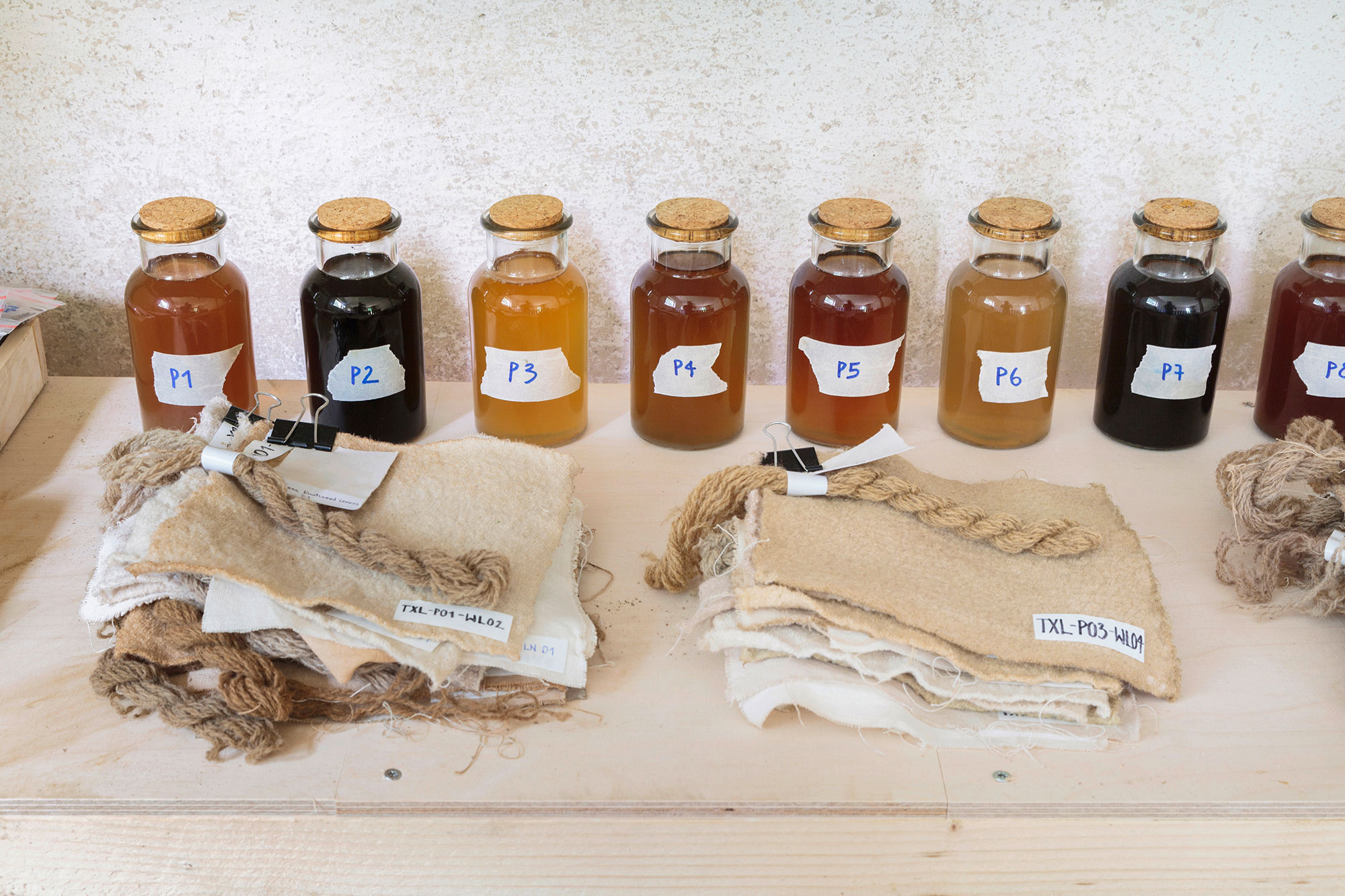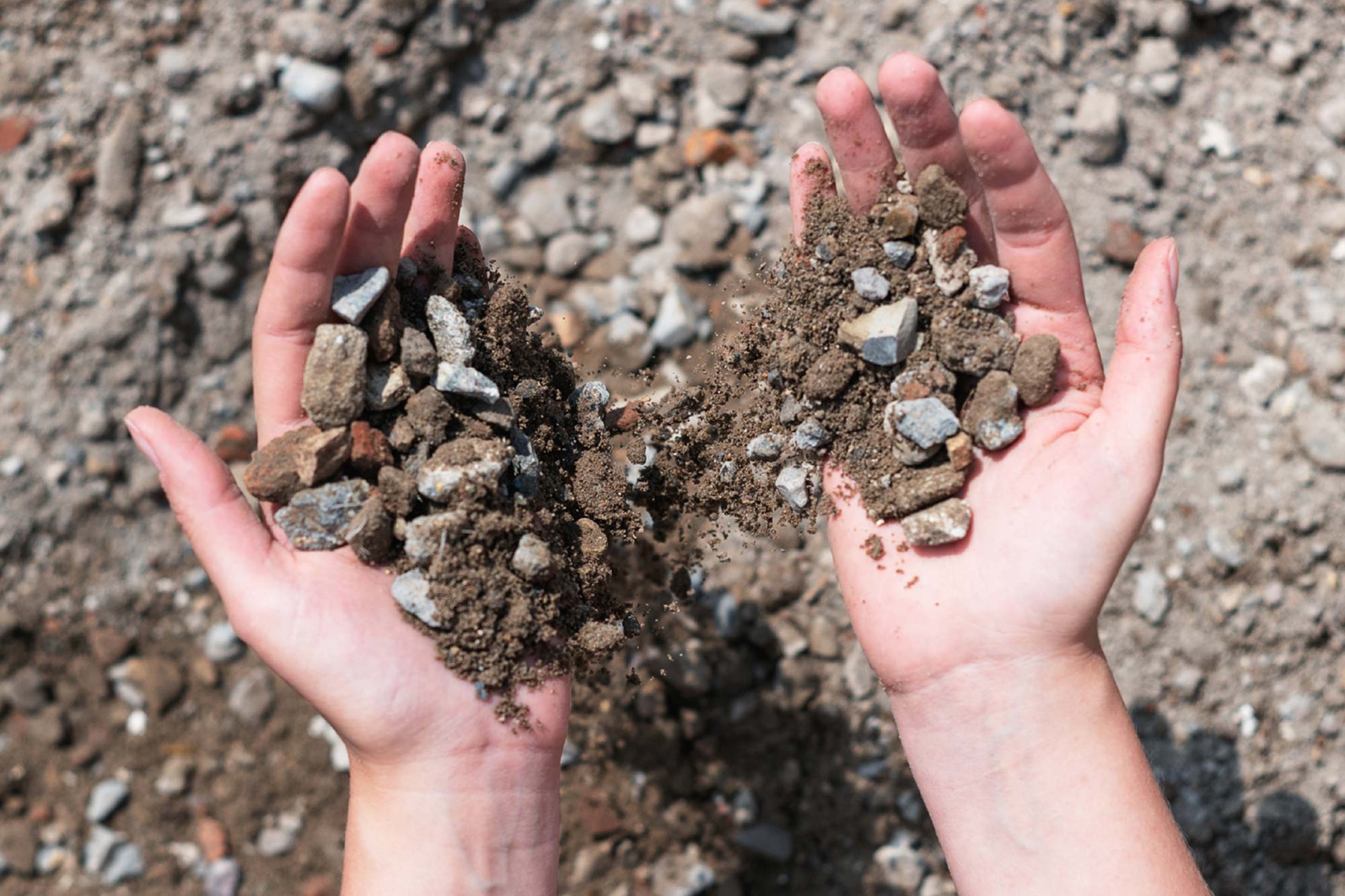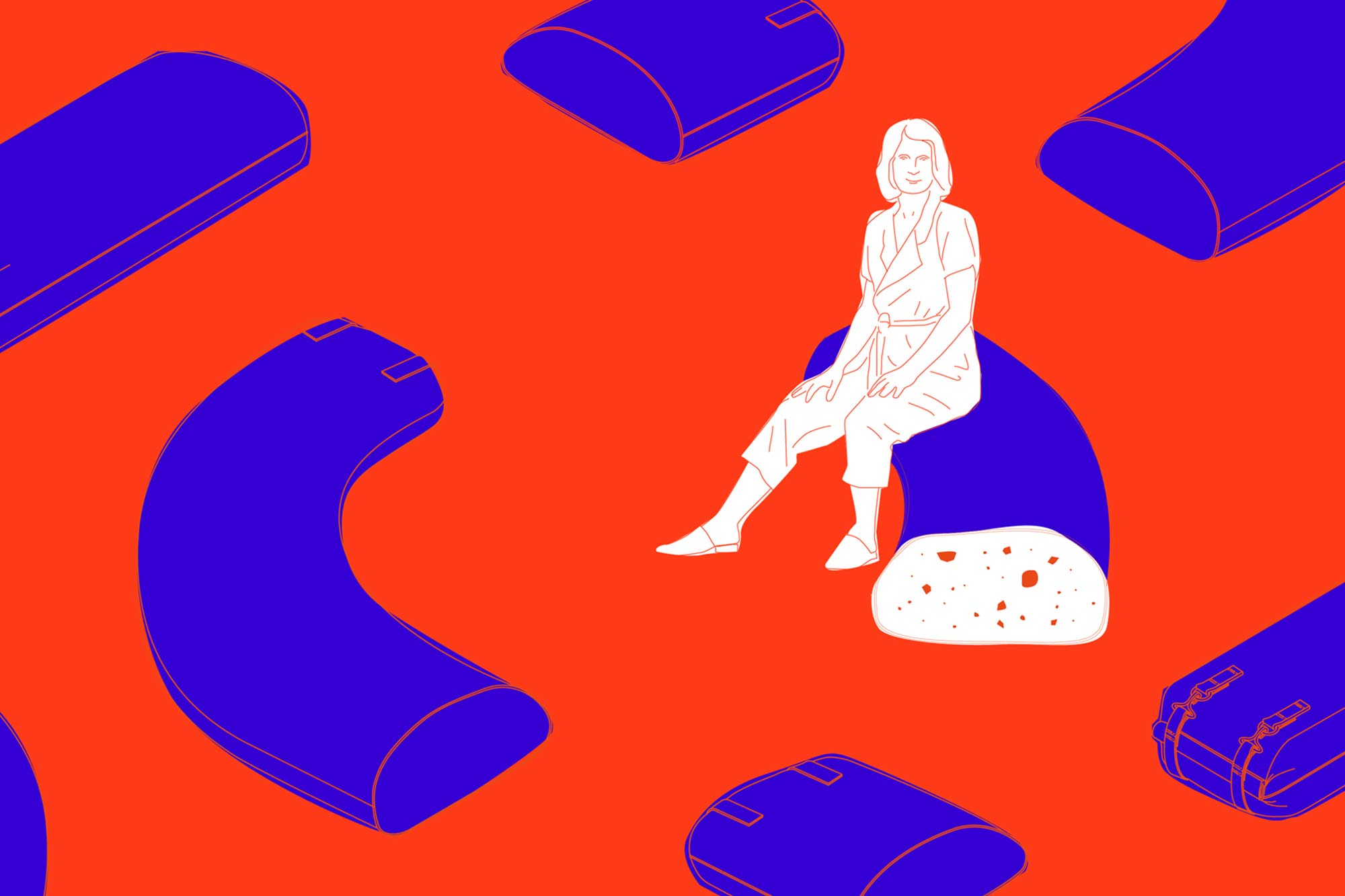Culture in Residency: Material Library
As part of the LINA Fellowship and collaboration with the Institute of Architecture and Design, Estelle Jullian, Thomas Amann, and I held a workshop with the Architecture students of TU Vienna that mapped out the ecological and industrial material landscape around the Campus of the Vienna Boys’ Choir. From these resources the students developed material recipes that would apply these so-called waste streams in a library of local architectural materials.

The Material Library has now permanently moved into the pig sty on the Campus of the Vienna Boy’s Choir in Sekirn, Austria, to inspire and inform future workshops.
How can we live – and create – on a damaged planet? If, as the philosopher Baptiste Morizot describes, the ecological crisis is also a crisis of sensitivity, how can we feel, understand and weave new relationships with respect to the territory and the matter of the objects that constitute our own daily life and the more-than-human life that surrounds us? As the architect tests the role of the mediator to help foster these connections, which tools, methodologies and (knowledge) collaborators are needed and which architectural possibilities spring from this framework?
The slowly deteriorating existing buildings and varied landscape of the Vienna Boys’ Choir campus offer a testing ground for radical strategies of adaptive reuse through local resources and material waste streams. The workshop explored the local landscape that is characterized by its partially natural and its partially industrial material and waste streams. The students mapped these local material streams directly on the territory and in regional proximity to Sekirn to trace the resources for our workshop.

The library includes several died textile samples and liquid pigments extracted from local invasive plant species.
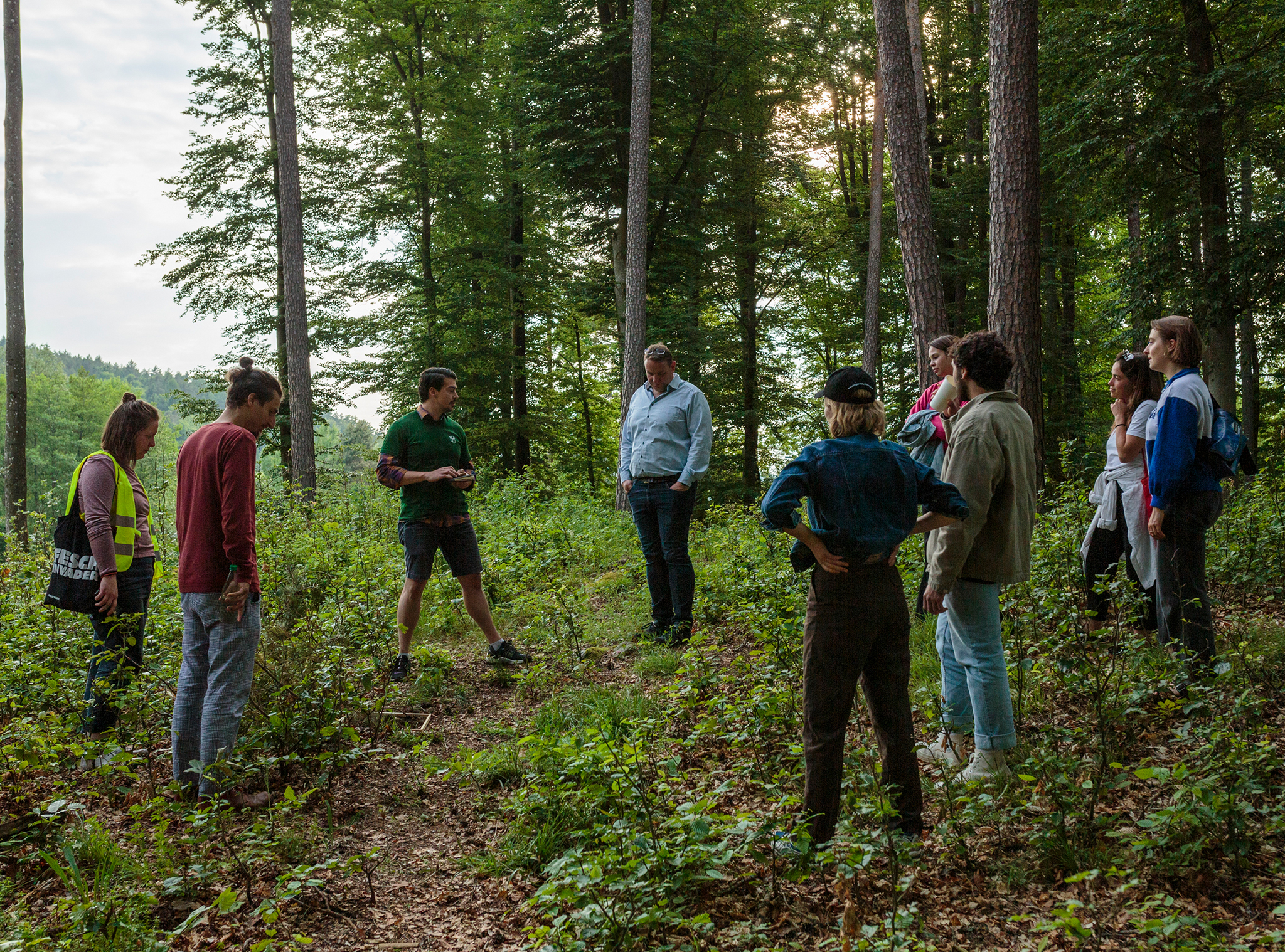
The Material Library is closely connected to the territory that houses it. Tours of the territory reveal these connections between the local ecology of the soil, lake and forrest to the material palette.
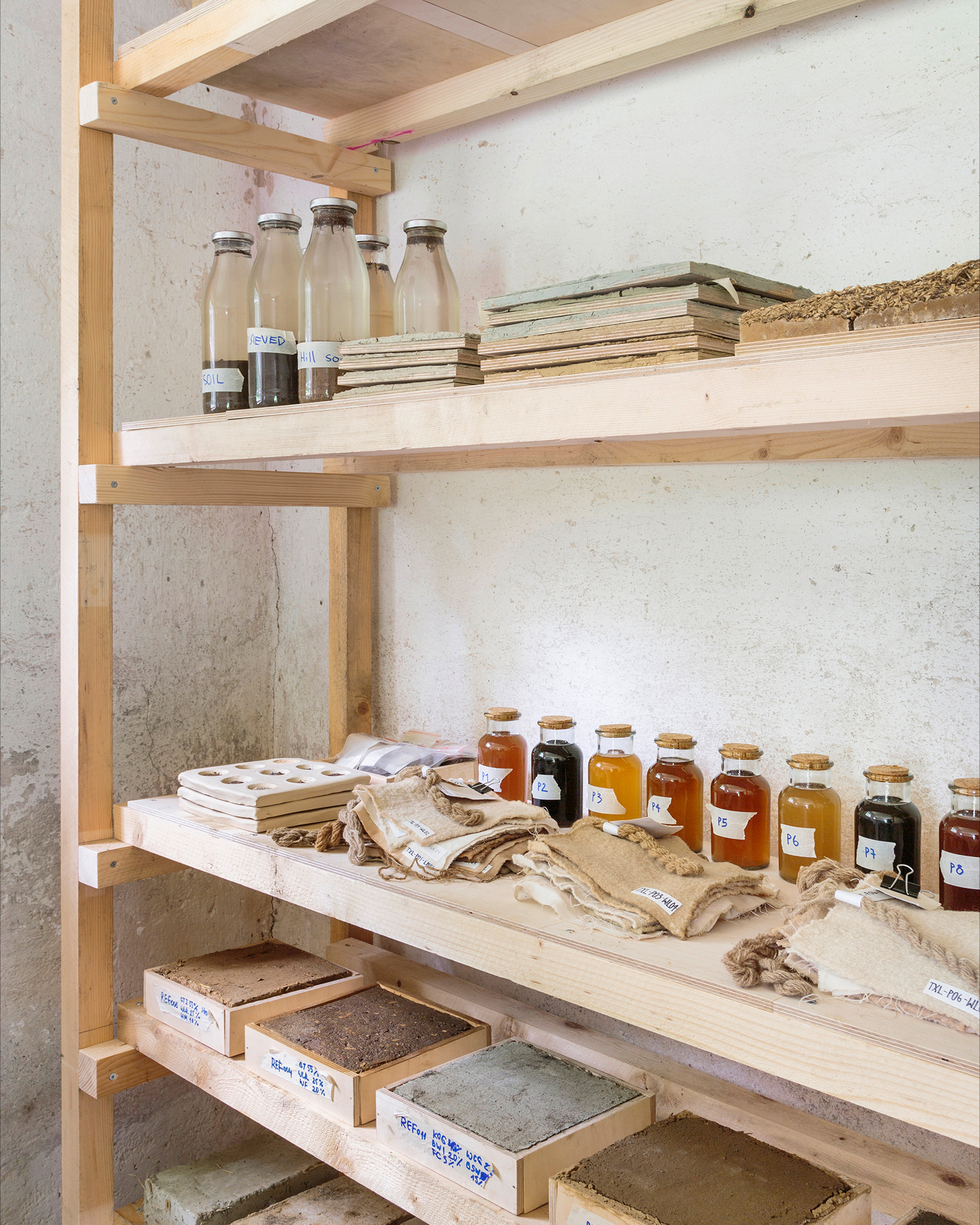
The samples contain both successful and failed experiments to inform future material research.
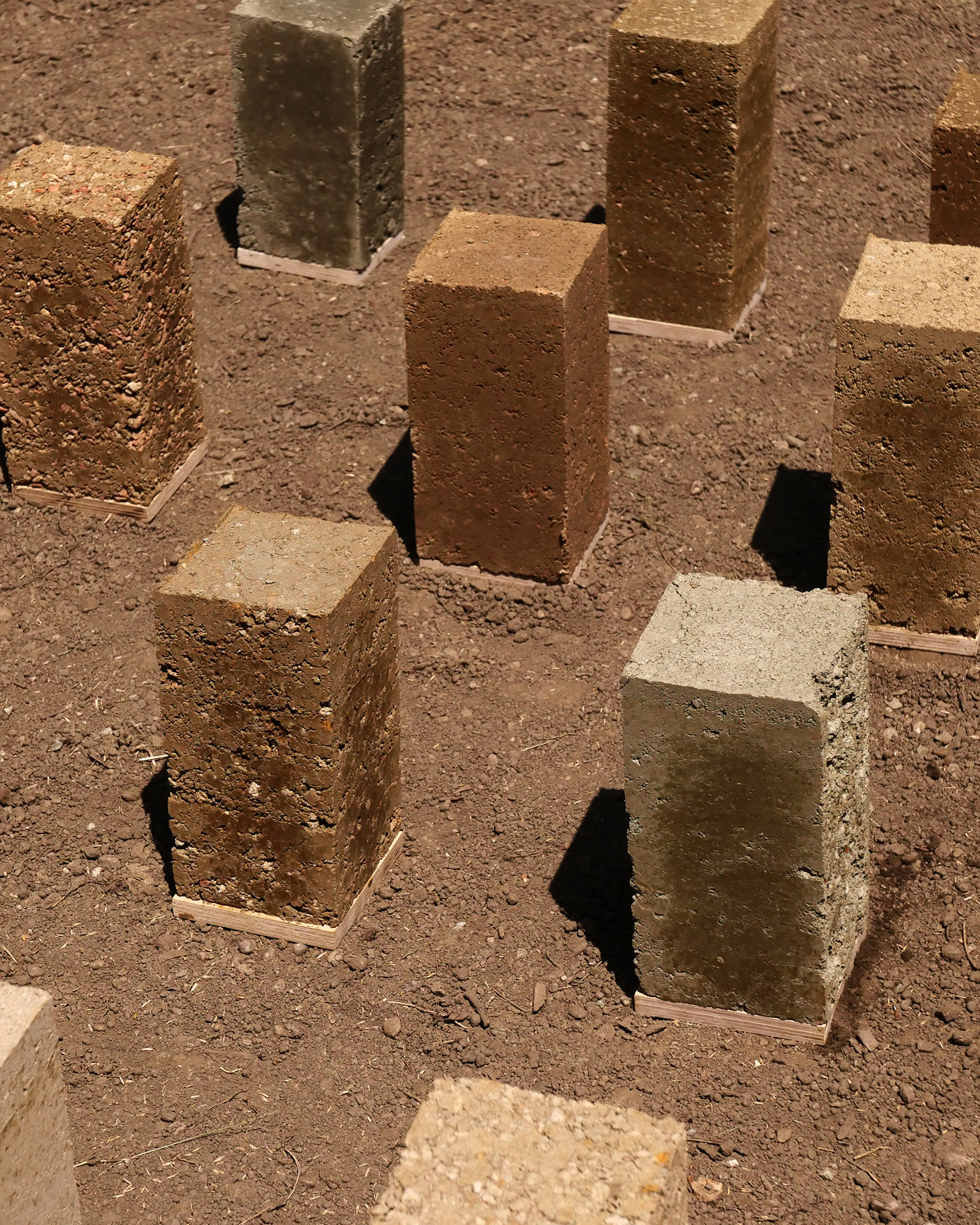
The students tested the use of crushed brick waste, stone dust, and mixed crushed construction waste among other local material streams in the development of a local rammed earth recipe.

All recipes began with a collection of raw material samples from agricultural and industrial (waste) material streams like the invasive Japanese knotweed, waste sheep wool, or crushed construction waste.
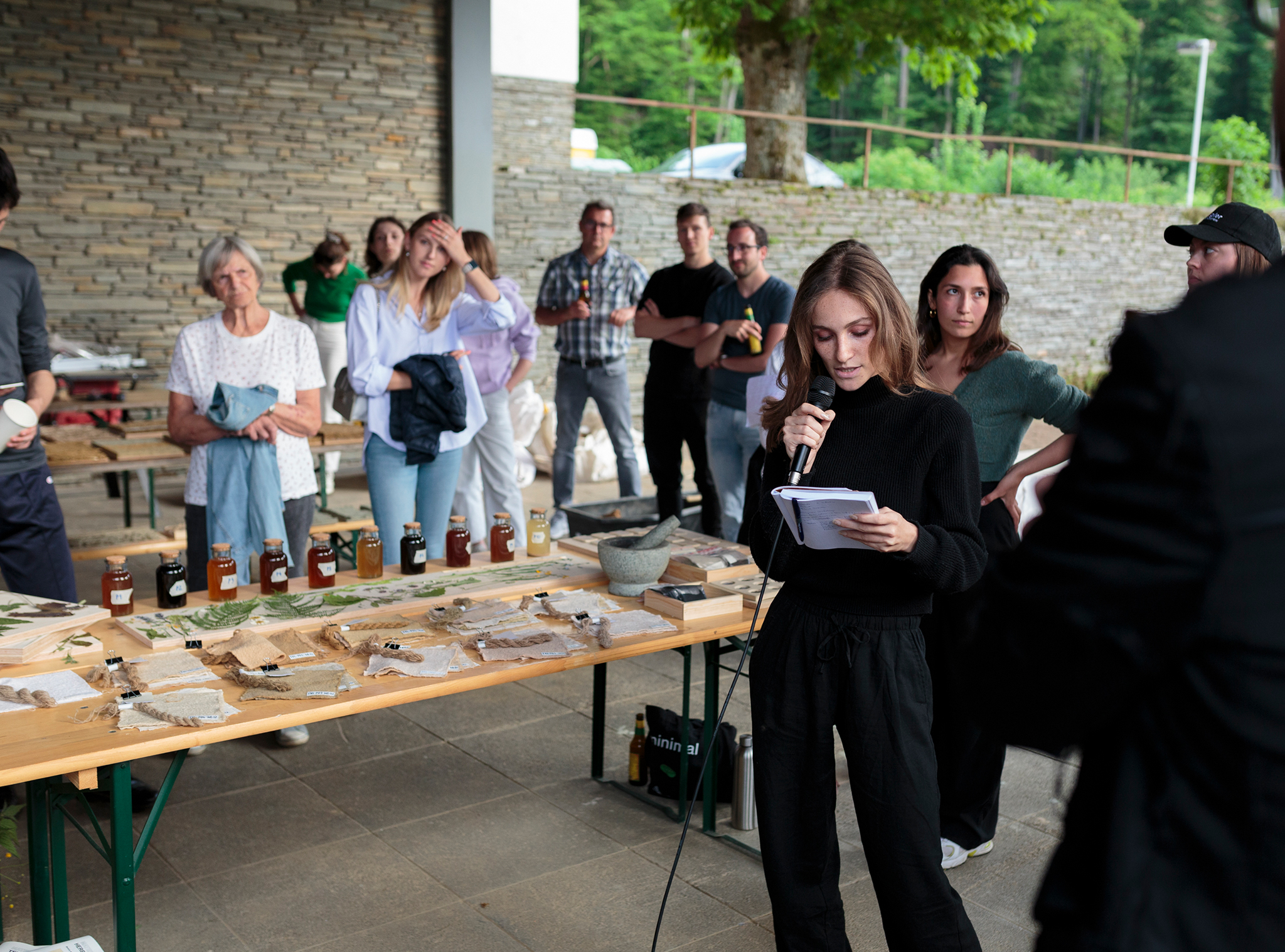
At the opening of the Material Library, the students guide their material partners, neighbours and tutors through their process.
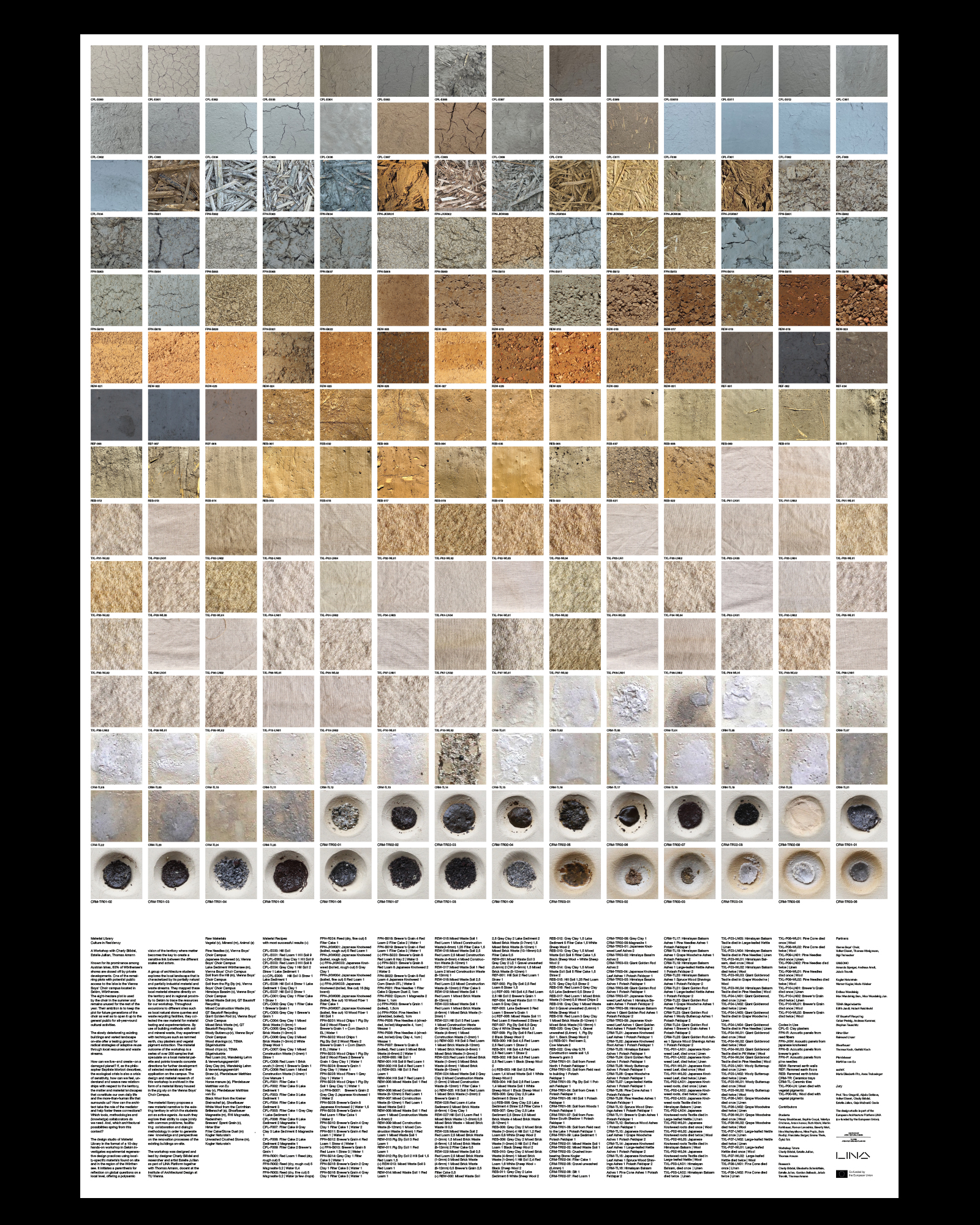
All material recipes, both failures and successes, are noted and archived in a recipe poster.
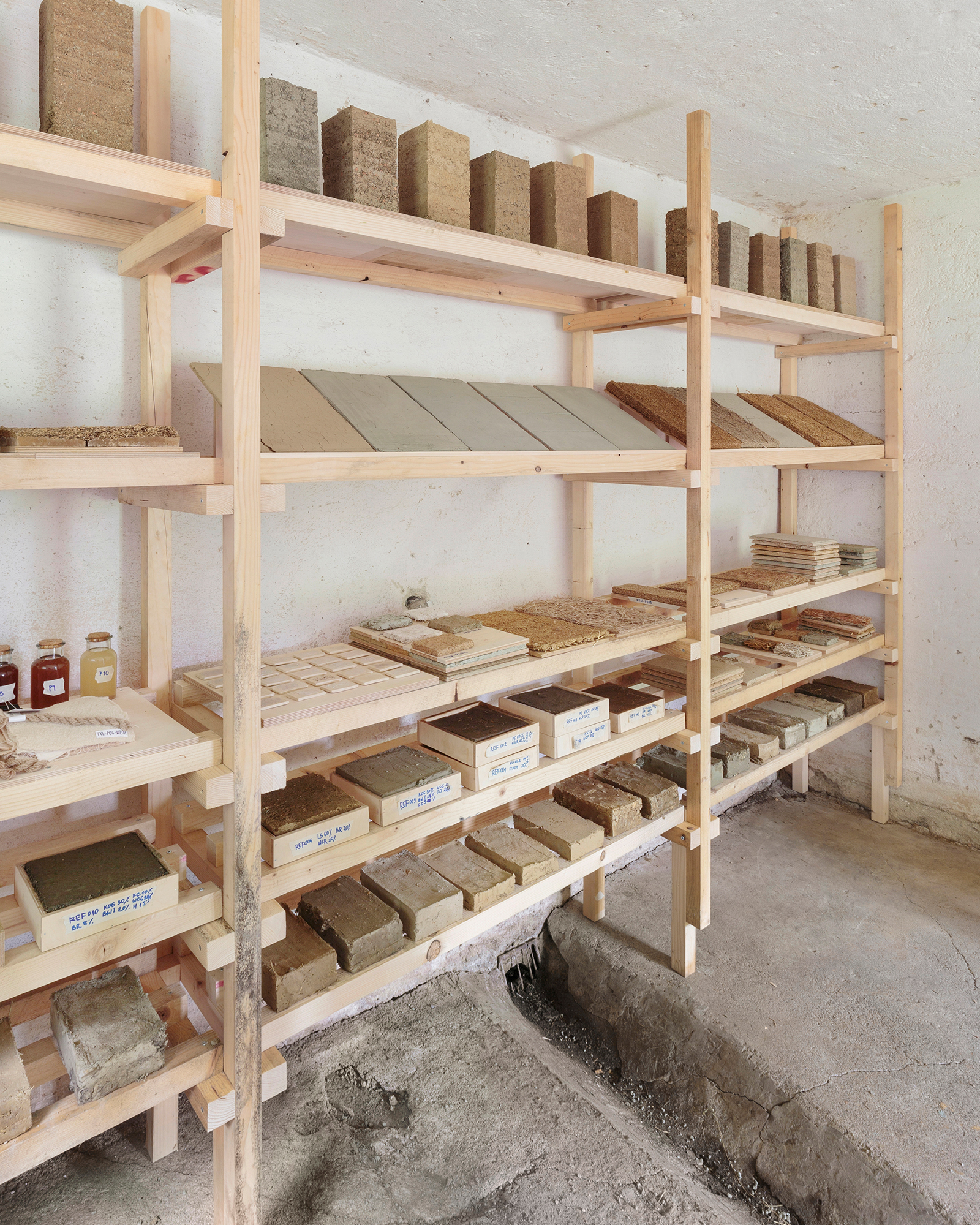
Throughout excursions to different sites such as local natural stone quarries and construction waste recycling facilities, we collected the raw material for material testing and experimentations. The outcome of the workshop is a series of material samples that speculate on a local material palette. These samples point towards concrete directions for further development of selected materials and their application on the campus. The design and material research of this workshop is archived in the form of a library for local material recipes which will be housed at the pig sty of the campus for future use and further exploration.
The material library proposes a new material narrative to the existing territory in which the students of TU Vienna act as active agents in coping jointly with common challenges, facilitating collaboration and dialogic methodologies in order to generate and draw on new knowledge(s) and perspectives in the specific context of the renovation processes on the Vienna Boys’ Choir campus.
Students
Fanny Bruckbauer, Sophie Coqui, Valeriya Gridneva, Anton Ivanov, Ruth Köchl, Martin Kohlbauer, Roman Levoshka, Beverly Mori, Irina Mezheynikova, Nina Popic, Sara Rodiqi, Franziska Sorger, Emma Theis, Öykü Tok
Workshop Tutors
Charly Blödel, Estelle Jullian, Thomas Amann
Jury
Prof. Tina Gregorič Aljoša Dekleva, Volker Dienst, Tina Gregorič, Estelle Julian, Gaja Mežnarić Osole
The design studio is part of the European Architecture Platform LINA (co-funded by the European Union).

© Charly Blödel, 2022. For more Imprint.
Building with Waste Streams
During a 10-day workshop developed with Estelle Jullian (LINA fellow) and Thomas Amann (TU Vienna), the Architecture Master Students mapped local agricultural waste streams and industrial byproducts in natural stone quarries, construction waste recycling facilities and wood manufacturers. Through material tests and prototyping, the students developed new material recipes that apply these material streams in a local architectural material palette, from recipes for rammed earth walls, bricks, earthen floors to ceramic Glaces and textiles died with invasive plants.

The quarry of Kogler Naturstein offers a range of products from natural stone slabs and crushed stone in various sizes. When stone is crushed and machines are cleaned, a fine stone dust is filtered out of the cleaning water: A filter cake that the students made use of in rammed earth, brick and plaster mixtures.
How can we live – and create – on a damaged planet? If, as the philosopher Baptiste Morizot describes, the ecological crisis is also a crisis of sensitivity, how can we feel, understand and weave new relationships with respect to the territory and the matter of the objects that constitute our own daily life and the more-than-human life that surrounds us? As the architect tests the role of the mediator to help foster these connections, which tools, methodologies and (knowledge) collaborators are needed and which architectural possibilities spring from this framework?

From crushed brick to stone dust and invasive Japanese knotweed the students explore these materials not as agricultural and industrial waste streams but as possible material streams that can be valuable in the development of local architectural materials.
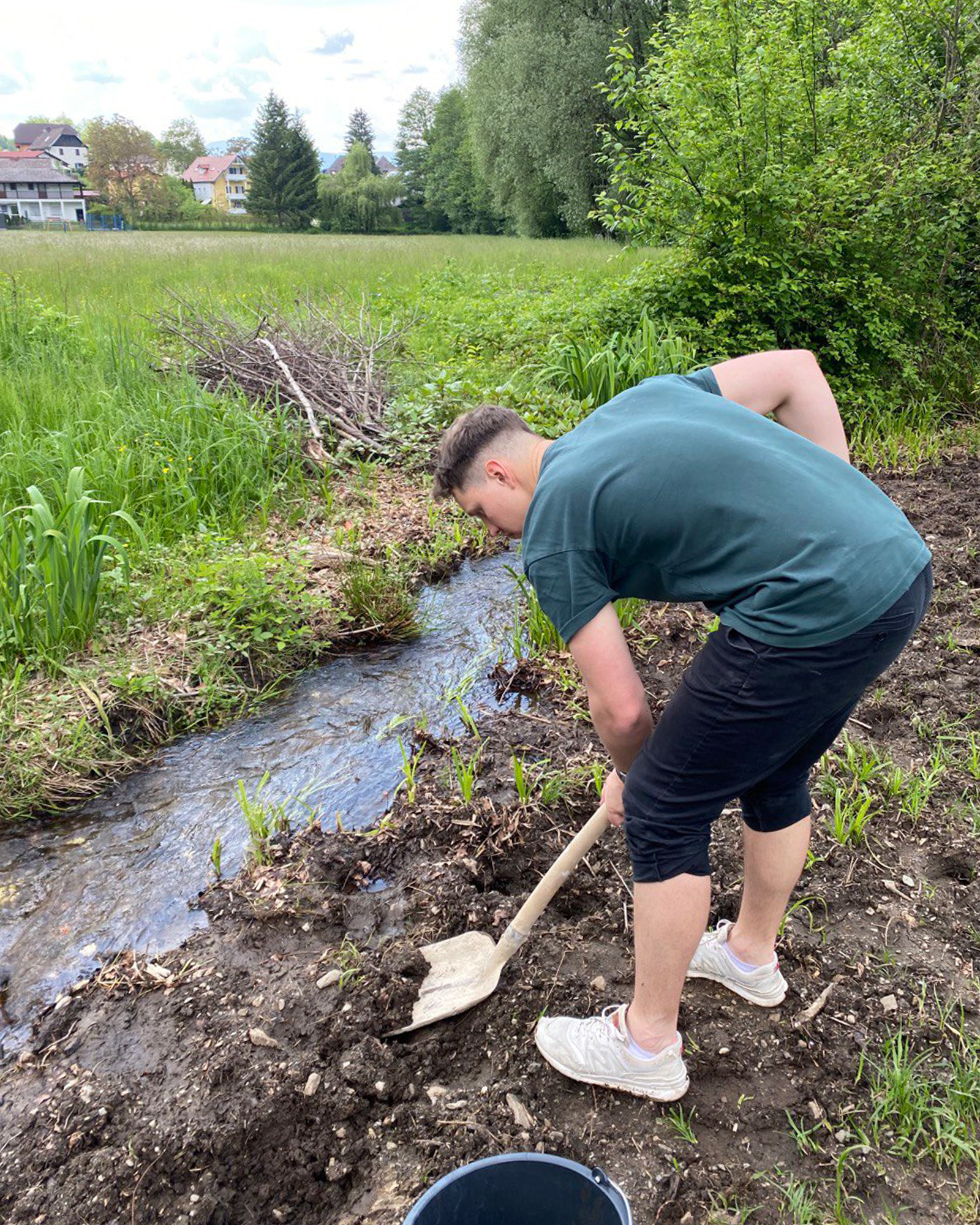
Different kinds of soil can be found on the Campus of the Vienna Boys’ Choir. Each location offers different properties in soils.

With a bottle test the students explore the properties of soils found on the territory of the Campus and waste soils from recycling sites.

The recipes reach from earthen walls and floors to ceramic glazes and died textiles.
The slowly deteriorating existing buildings and varied landscape of the Vienna Boys’ Choir campus offer a testing ground for radical strategies of adaptive reuse through local resources and material waste streams. The workshop explored the local landscape that is characterized by its partially natural and its partially industrial material and waste streams. The students mapped these local material streams directly on the territory and in regional proximity to Sekirn to trace the resources for our workshop.
Throughout excursions to different sites such as local natural stone quarries and construction waste recycling facilities, we collected the raw material for material testing and experimentations. The outcome of the workshop is a series of material samples that speculate on a local material palette. These samples point towards concrete directions for further development of selected materials and their application on the campus. The design and material research of this workshop is archived in the form of a library for local material recipes which will be housed at the pig sty of the campus for future use and further exploration.

Through frequent adjusting of ratios and testing of material properties, the students refine their final recipes.
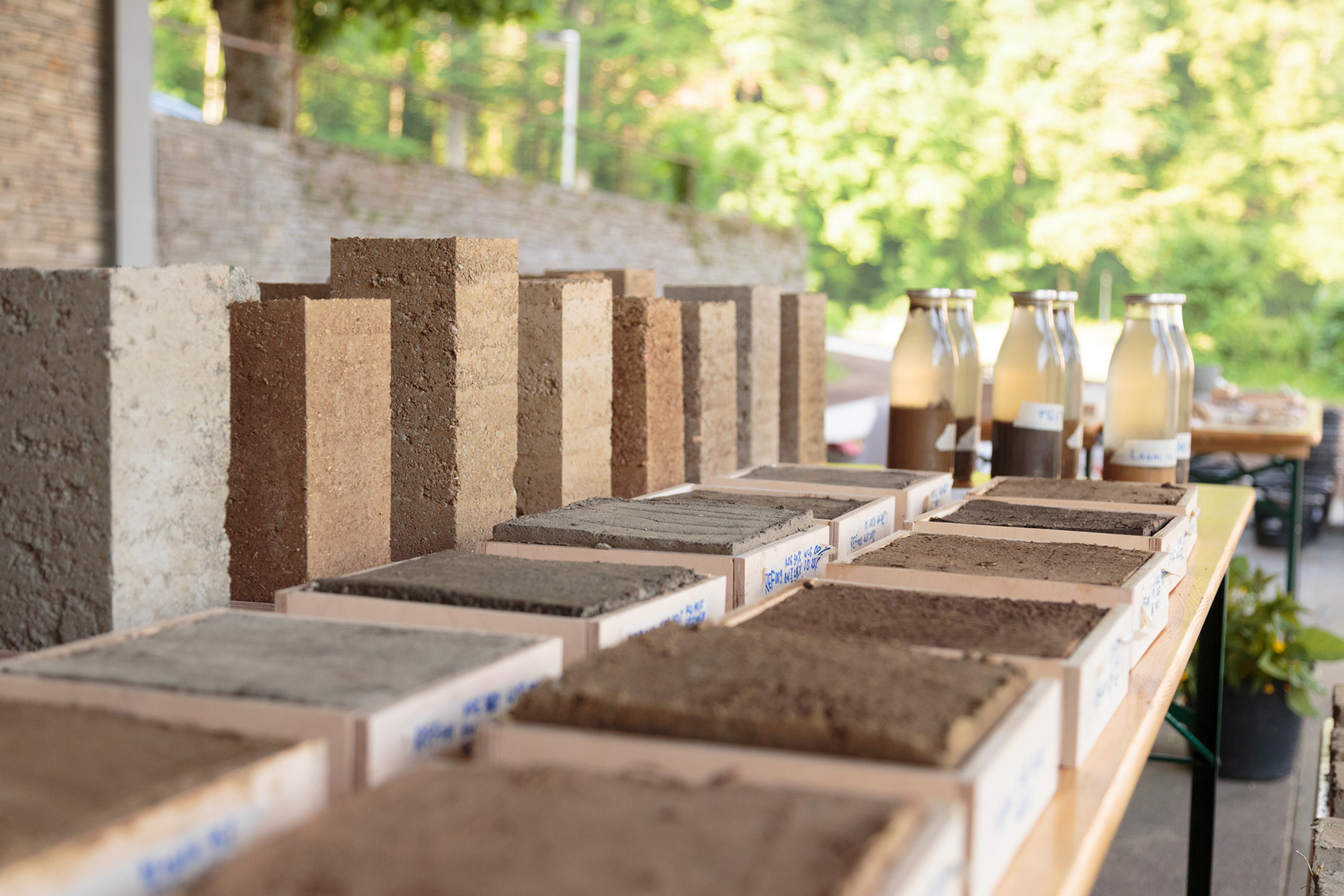
The result: a material library of industrial waste streams applied in a local architectural material palette.
The material library proposes a new material narrative to the existing territory in which the students of TU Vienna act as active agents in coping jointly with common challenges, facilitating collaboration and dialogic methodologies in order to generate and draw on new knowledge(s) and perspectives in the specific context of the renovation processes on the Vienna Boys’ Choir campus.
Students
Fanny Bruckbauer, Sophie Coqui, Valeriya Gridneva, Anton Ivanov, Ruth Köchl, Martin Kohlbauer, Roman Levoshka, Beverly Mori, Irina Mezheynikova, Nina Popic, Sara Rodiqi, Franziska Sorger, Emma Theis, Öykü Tok
Workshop Tutors
Charly Blödel, Estelle Jullian, Thomas Amann
Jury
Prof. Tina Gregorič Aljoša Dekleva, Volker Dienst, Tina Gregorič, Estelle Julian, Gaja Mežnarić Osole The design studio is part of the European Architecture Platform LINA (co-funded by the European Union).
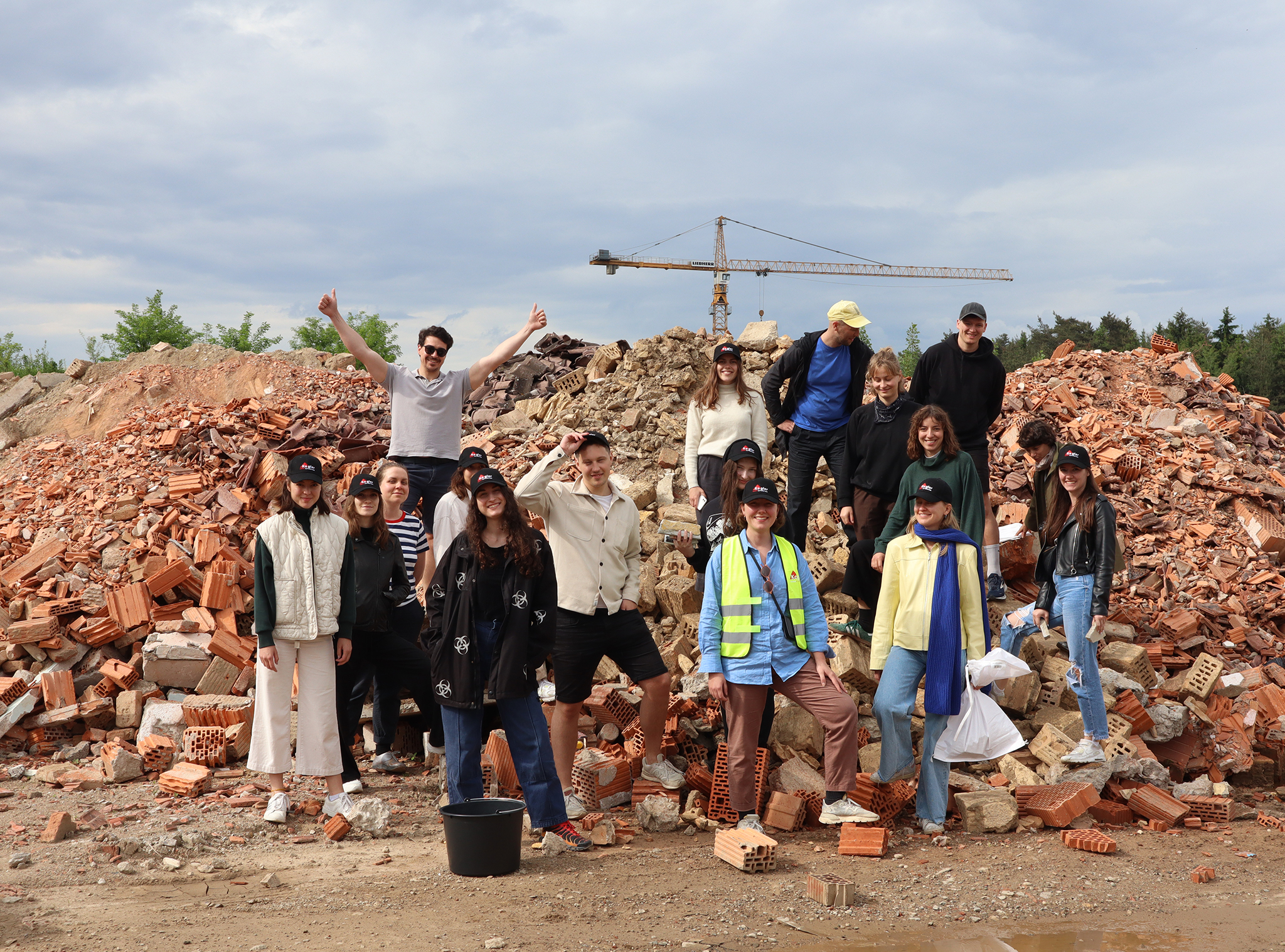
The students of the Institute of Architecture and Design, TU Vienna, with tutors Thomas Amann, Estelle Jullian and Charly Blödel during one of the excursions to GT Baustoff Recycling.
© Charly Blödel, 2022. For more Imprint.
Work Conference – No More Building as Usual: Architecture Beyond Carbon and Greed
On June 24, the Rotterdamse Academie van Bouwkunst hosted the work conference No More Building as Usual: Architecture Beyond Carbon and Greed. Next to plenary presentations by Maria Lisogorskaya (Assemble), Maarten Gielen (Rotor) and Winne van Woerden (Commons Network), five sessions framed open conversations in which the academy community defined several positions that architects and urban designers can take up in the face of eco-social challenges.
Charly Blödel was part of the session of Building Rituals: Circular building, non-destructive construction and regenerative materials are coming to define tomorrow’s architecture. What are the new protocols, values and aesthetics we should get familiar with? With a.o. Estelle Barriol (Studio ACTE), Charly Blödel (Nieuwe Instituut), Maarten Gielen (Rotor), Roxane van Hoof and Claudio Saccucci (Studio Verter), Edgars Jane (KCAP), Laura van Santen (La-di-da) and Sven Schouten (student).
The built environment is one of the largest drivers of natural resource depletion, ecosystem destruction, rising temperatures and more extreme weather conditions, and increasing socioeconomic inequality. Designers and other actors in the production of space play an important role in this and are responsible for developing alternative building practices that help counter these negative trends.
On Saturday June 24 the Rotterdamse Academie van Bouwkunst organised a gathering to discuss new roles that architects and urban designers can take up. How can we give shape to a different planning, design culture and construction industry? How can we learn to have positive footprints before a carbon lockdown goes into effect? What does it mean to approach the (built) environment from a perspective of regeneration? What type of architects do we want to be? And how can we do so in a healthy work culture? We want to explore a way of working that goes beyond the competitive model of individual success and soloist genius, towards one of collaboration around socio-ecological ambitions.
Architect Edgars Jane who participated in the session of Building Rituals reflected on the programme of the conference in his article ‘RADICAL SUFFICIENCY: is this it?’.
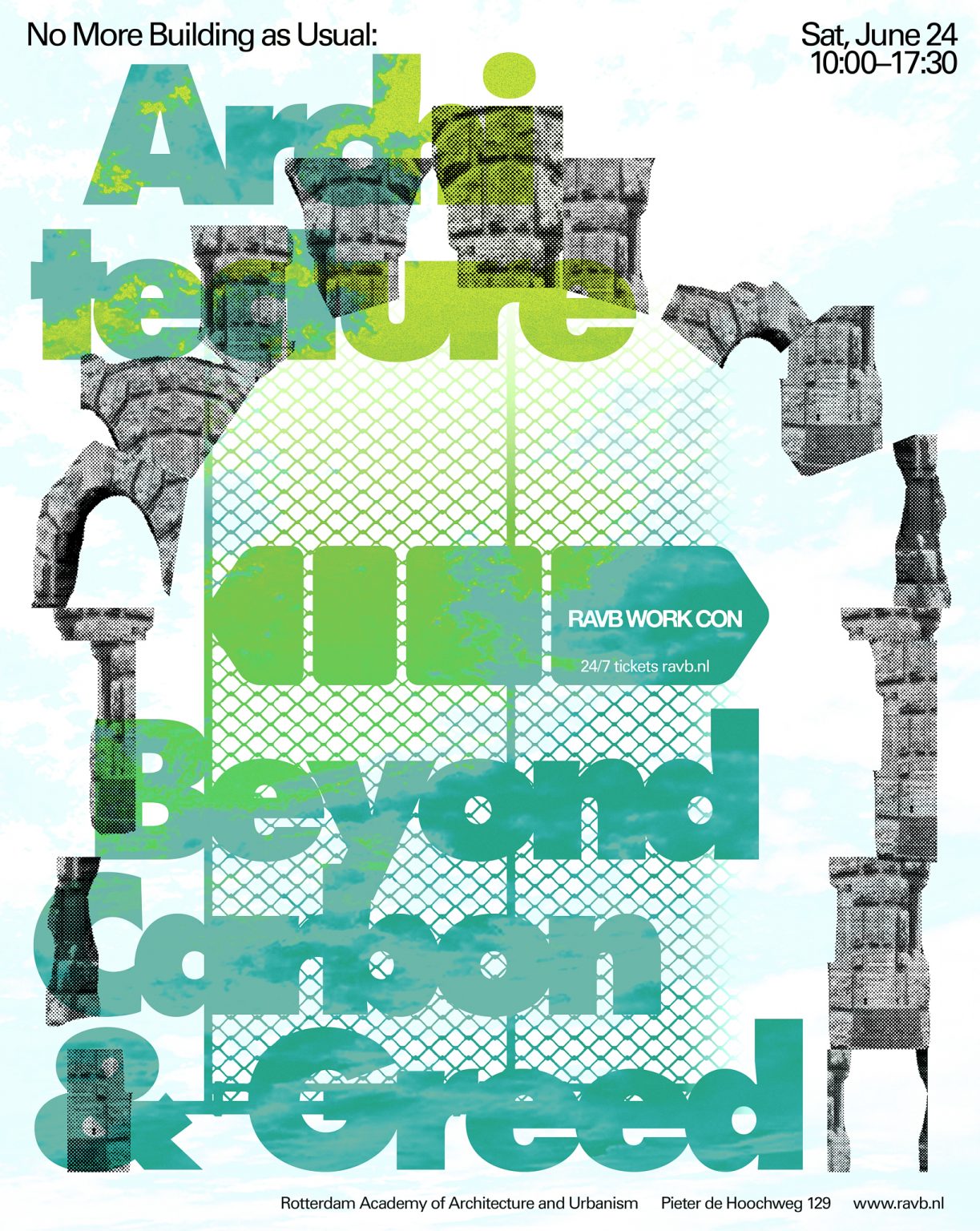
© Charly Blödel, 2022. For more Imprint.
Design studio: One More Time With Feeling
How can we make buildings again from the buildings we demolish? What architecture can we imagine, if fragments, rubble and debris are the main building blocks? The studio ‘One More Time With Feeling’ at the Rotterdamse Akademie van Bouwkunst in Rotterdam proposes reuse as a conceptual approach to architecture and practices of building or un-building. During the semester, large plaster models of generic building structures were made through which the process of demolition was simulated to scale and served as the material basis for making a design.

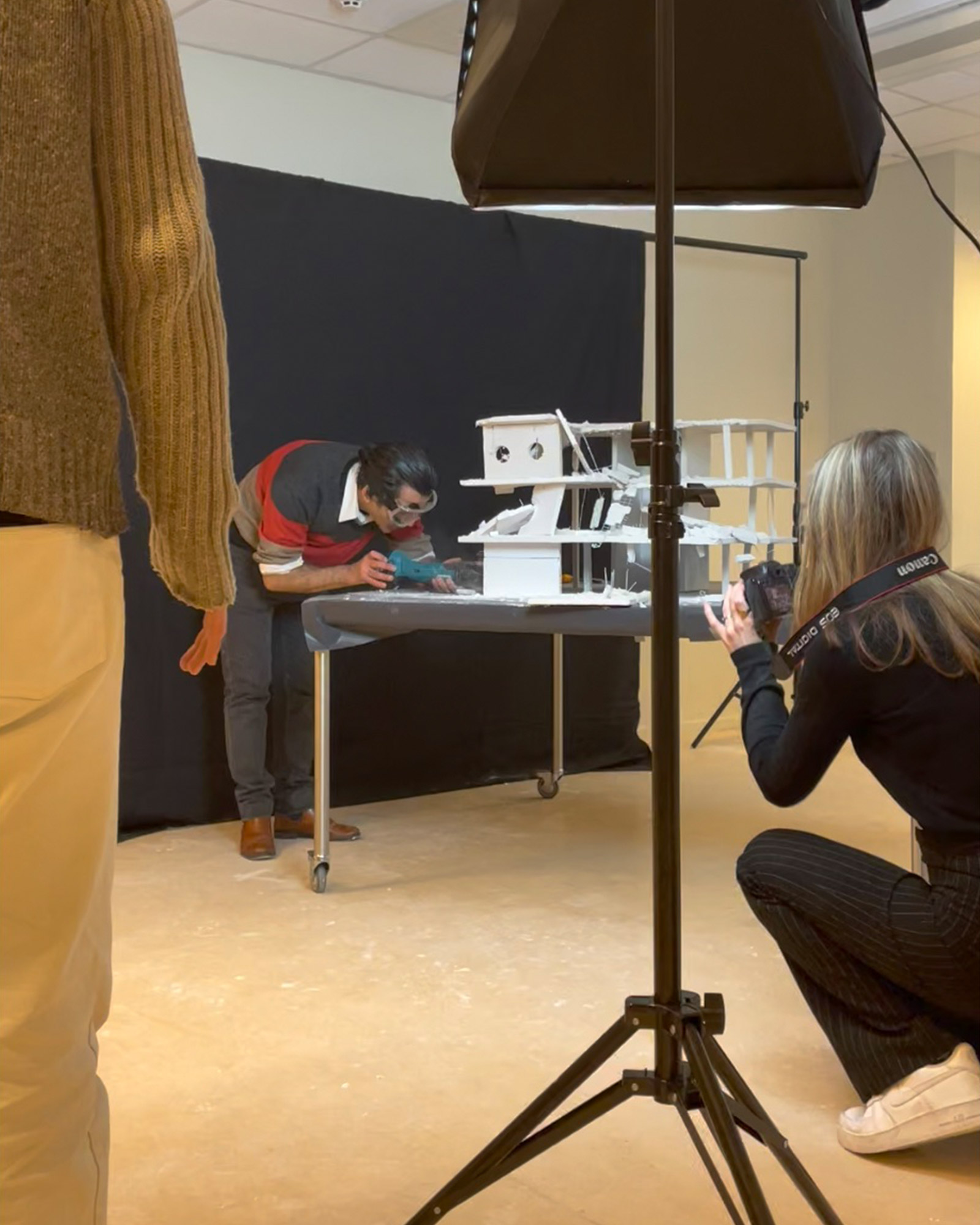
Students
Jurrian Blom, Shamal Soltani, Seyed Farzad Hosseini, Corne bij de Vaate, Joris Warndorff, Jorien Rijper, Elias T’Joens, Anne Spanjaards, Linde Spuijbroek, Merve Coban
Tutors
Tomas Dirrix, Julia Strömland, Charly Blödel, Bas Leemans
Visiting critic
Laura van Santen, Ladida Architects
© Charly Blödel, 2022. For more Imprint.
KLUTZ: (Zoom) Lecture & Open Call
As a prelude to the Architekturwoche Basel 2022, Charly Blödel will give a (zoom) lecture (in German) on 21 April, 17:30–18:30 at FHNW, Basel (CH).
In tandem with the lecture Team KLUTZ launches an Open Call for students to participate in the performative build-up on 6 and 7 May, 2022, at the Basel Pavillon, the main location of the Architekturwoche Basel 2022 where KLUTZ will become a meeting point and forum for panel discussions, interviews and lectures throughout AWB from 09–15 May and summer programme 2022.
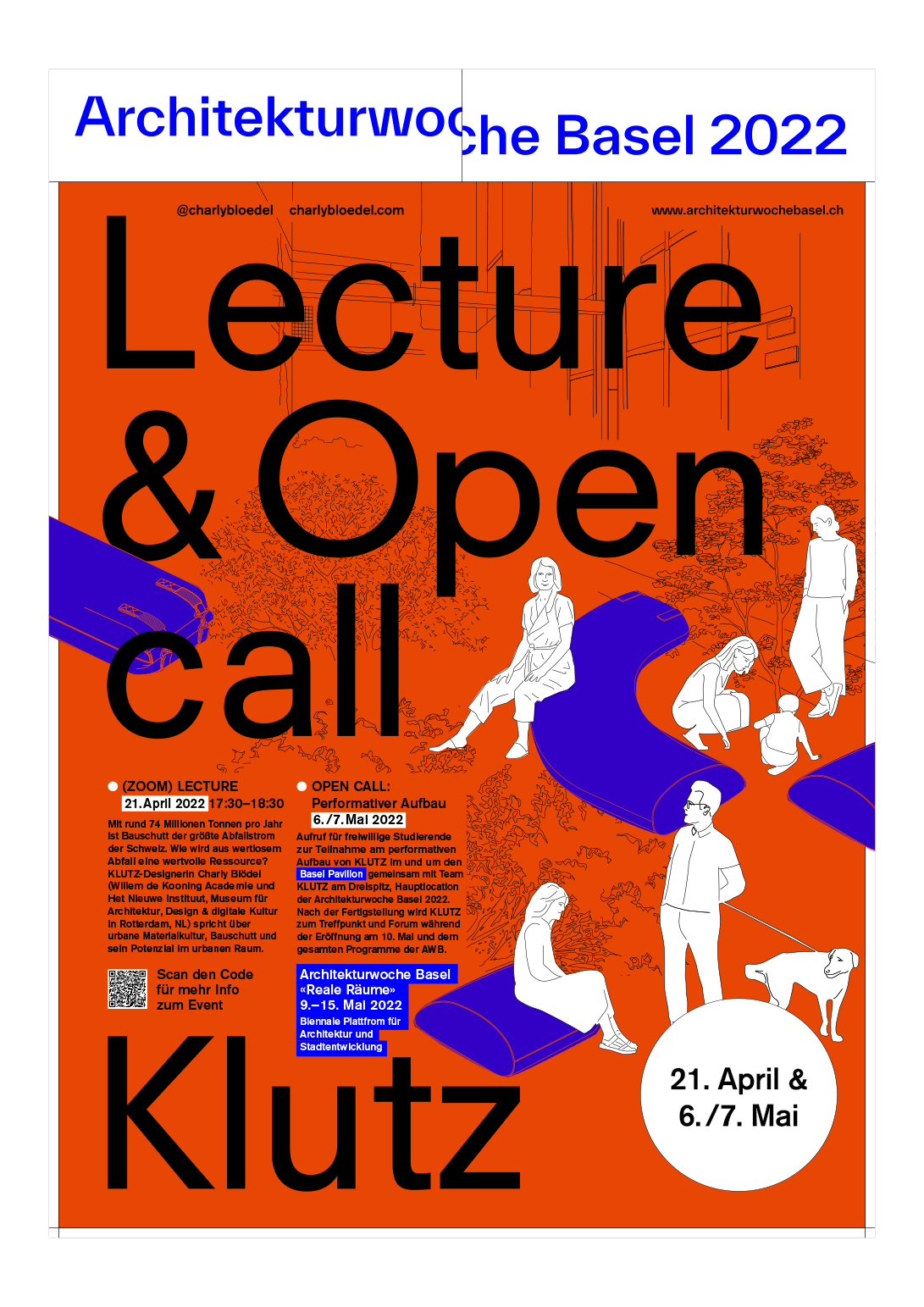
(ZOOM) LECTURE
21 April, 2022, 17:30–18:30
At around 74 million tons per year, construction waste is the largest waste stream in Switzerland. How do you turn worthless waste into a valuable re-source? KLUTZ-designer Charly Blödel (Tutor at Willem de Kooning Academie and programme and exhibition producer at Het Nieuwe Instituut, Museum for Architecture, Design & e-Culture in Rotterdam, NL) talks about material culture, construction waste and its potential to return to the public sphere.
SIGN UP for the lecture via Eventbrite.
OPEN CALL
6/7 May, 2022
On 6 and 7 May, 2022, Team KLUTZ will set up the temporary urban furniture cluster KLUTZ in and around the Basel Pavillon at Dreispitz. We invite student volunteers to join the team in the performative build-up in preparation for the opening of the Architekturwoche Basel 2022. The Basel Pavillon is the main location of AWB 2022. Once completed, Klutz will become a meeting point and forum at Dreispitz during the opening on 10 May and the entire programme of AWB 2022. Team KLUTZ is looking forward to seeing you!
SIGN UP for the KLUTZ performative build-up during the (Zoom) Lecture on 21 April
or directly via mail to hello@charlybloedel.com.
How does worthless waste become a valuable resource? KLUTZ-designer Charly Blödel talks about urban material culture, construction waste and its potential to return into public space. At around 74 million tons per year, construction waste is the largest waste stream in Switzerland. As mixed construction waste, concrete, brick, tile and asphalt are not used to construct new buildings, but are used as secondary materials to fill depleted quarries and other landscape and infrastructure work. Thus, a material that was originally mined from the natural landscape as a valuable raw material now flows back into a man-made landscape as a worthless waste material. How can worthless waste become a valuable resource? This is the question posed by KLUTZ.
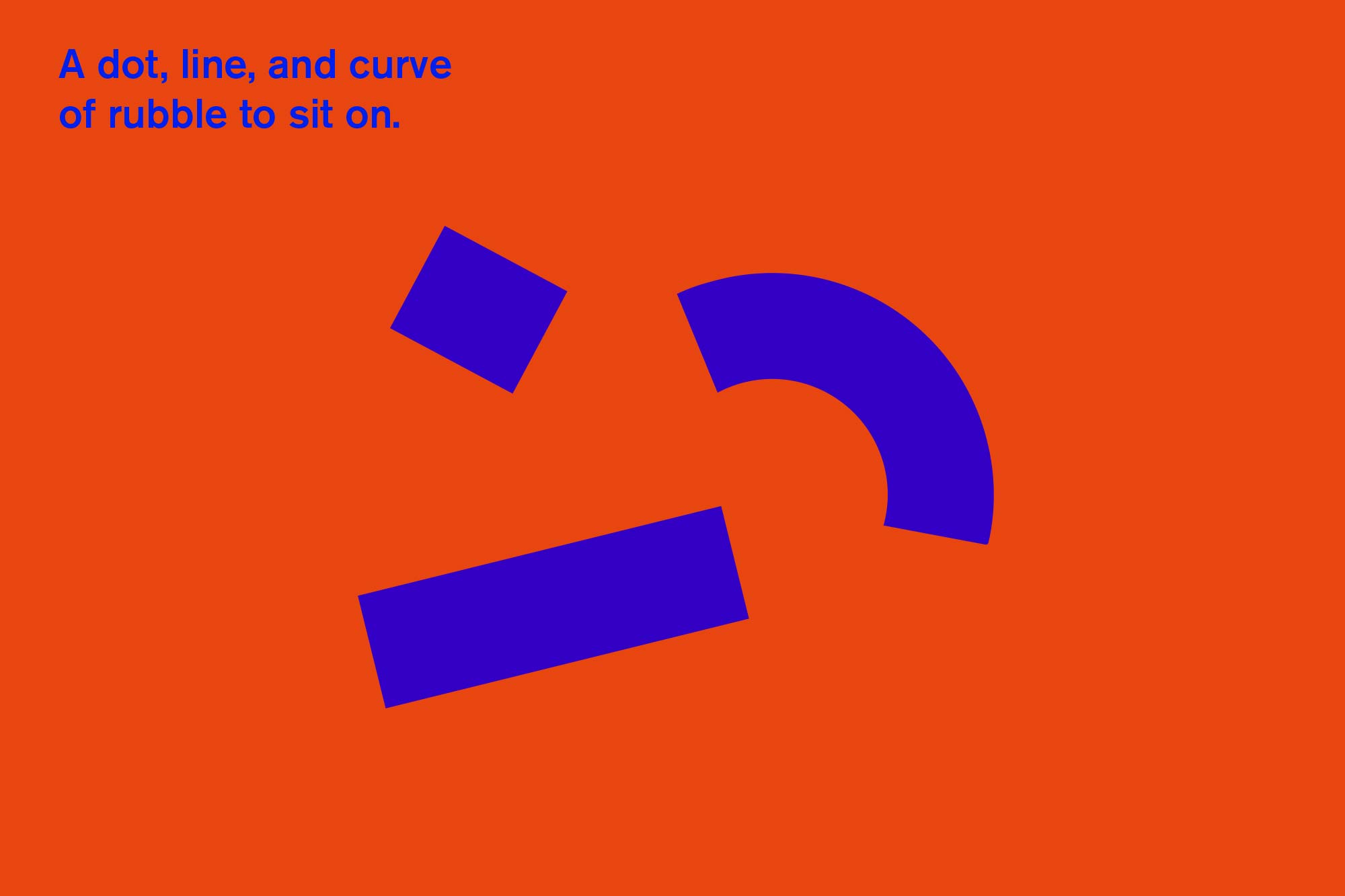
As a bag-module, KLUTZ will provide the context for panel discussions, interviews and lectures at the Basel Pavillon, the main location of the Architekturewoche Basel 2022.
KLUTZ is an urban furniture made of textile, on show for the first time during Architekturwoche Basel 2022. However KLUTZ only becomes a seat when it is filled with construction waste. As a bag module, KLUTZ is easy to transport, empty and refill. This is how KLUTZ travels through different urban contexts. “What’s in the bag?” is the recurring question. In a variety of spatial configurations and mixtures of filling materials, KLUTZ becomes a performative tool to engage with the changing value of the material that our built surroundings are made of.
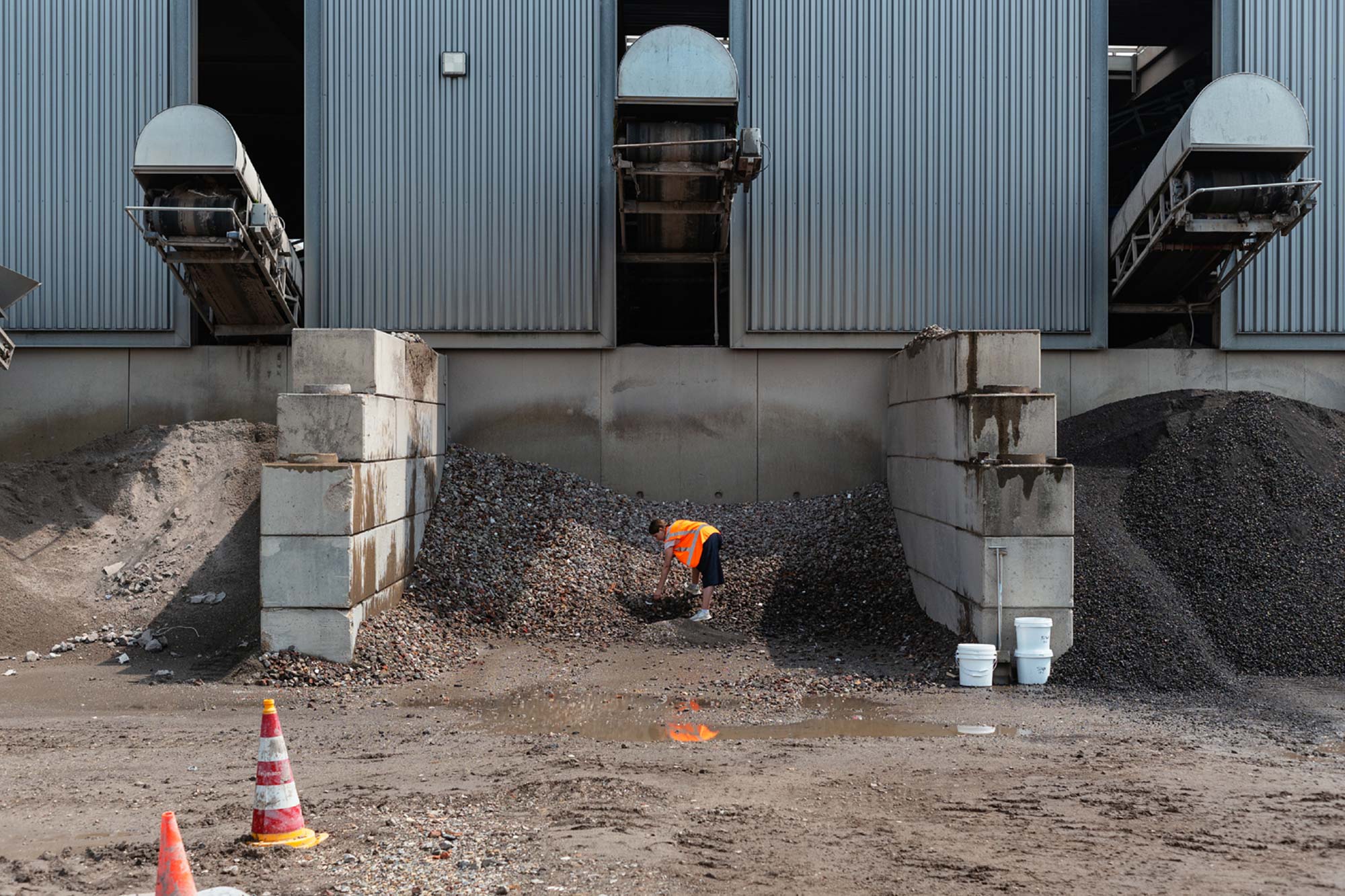
KLUTZ is part of the object family Soft Rubble, a series of spatial constructs in which building rubble and textile find spatial expression sometimes as a wall segment, sometimes as urban furniture. In the project Soft Rubble, which Charly Blödel started during her master studies at the Design Academy Eindhoven (2020), she focuses on the social and ecological implications of spatial design and production systems with a special focus on waste and material culture in the context of the climate crisis.
For more information on KLUTZ at Architekturwoche Basel 2022 and the programme from 09–15 May, 2022, please visit architekturwochebasel.ch
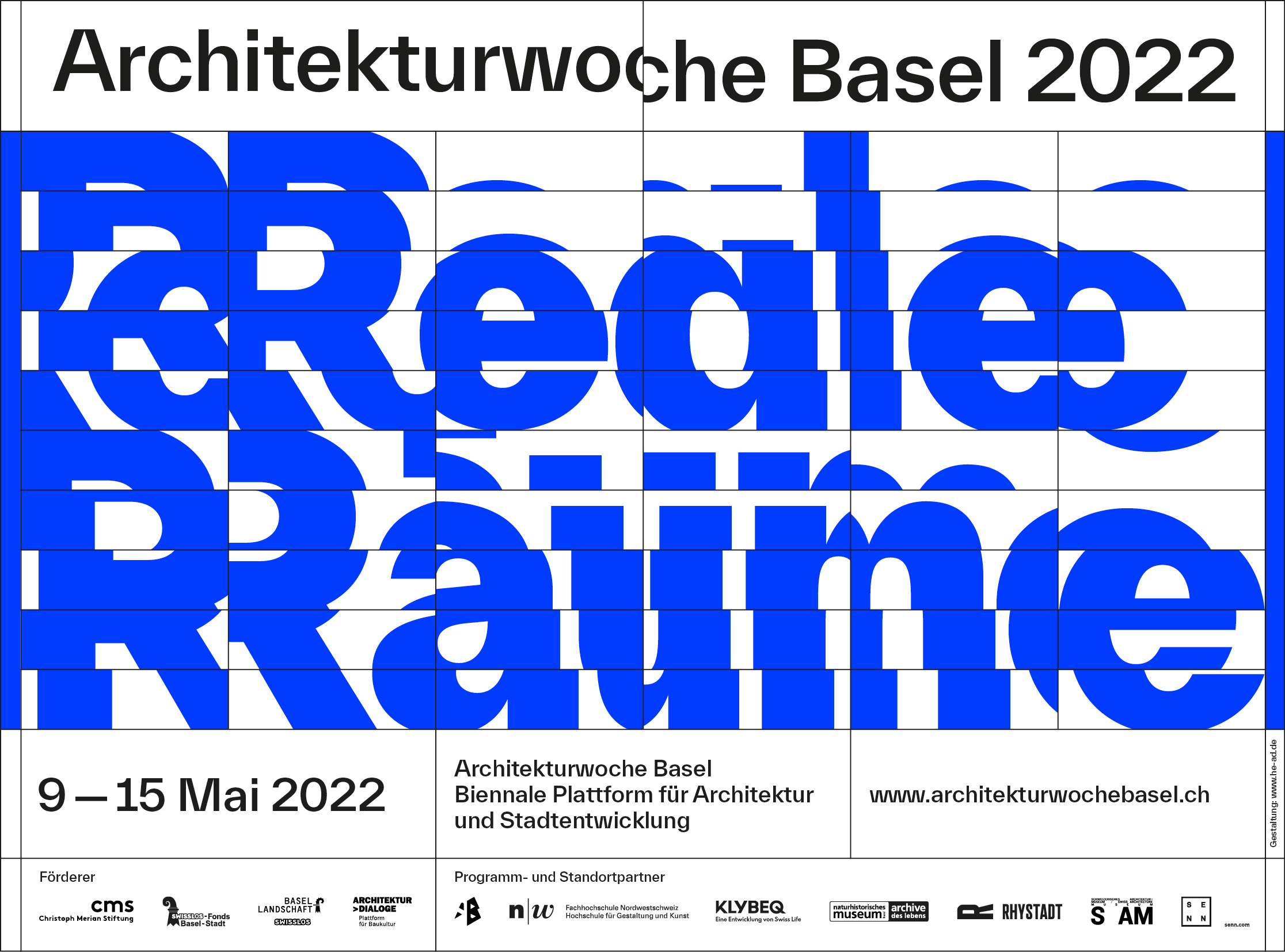
© Charly Blödel, 2022. For more Imprint.
KLUTZ @ Architekturwoche Basel 2022
At around 74 million tons per year, construction waste is the largest waste stream in Switzerland. As mixed construction waste, concrete, brick, tile and asphalt are not used to construct new buildings, but are used as secondary materials to fill depleted quarries and other landscape and infrastructure work. Thus, a material that was originally mined from the natural landscape as a valuable raw material flows back into a man-made landscape as a worthless waste material. How can worthless waste become a valuable resource? This is the question posed by KLUTZ, an urban furniture made of textile and building rubble.
KLUTZ is on show for the first time as part of the Basel Pavillon at Dreispitz, during Architekturwoche Basel from 09–15 May, 2022.
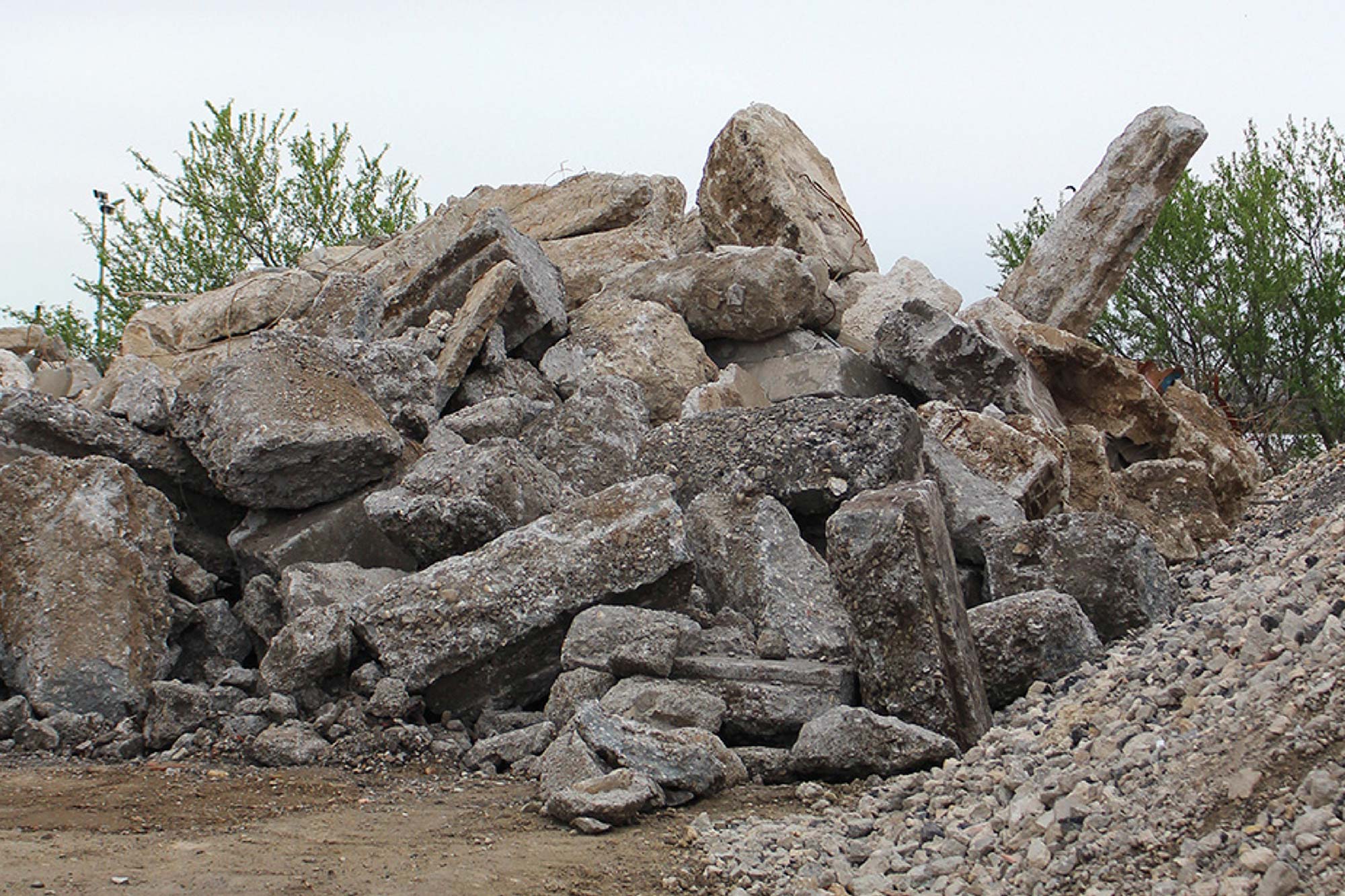
KLUTZ is an urban seating furniture made of textile. But it is only by filling it with construction waste that KLUTZ becomes a seat. As a bag module, KLUTZ is easy to transport, empty and refill. This is how KLUTZ travels through different urban contexts. “What’s in the bag?” is a recurring question. In a variety of spatial configurations and mixtures of filling materials, KLUTZ becomes a performative tool to engage with the interplay of value and valuelessness in urban space.

KLUTZ is built by hand in a performative build-up the start of the architecture week.

As a cluster of bag-modules, KLUTZ will provide the context for panel discussions, interviews and lectures at the Basel Pavillon, the main location of the Architekturewoche Basel 2022.

As a bag-module, KLUTZ will provide the context for panel discussions, interviews and lectures at the Basel Pavillon, the main location of the Architekturewoche Basel 2022.
KLUTZ is part of the object family Soft Rubble, a series of spatial constructs in which building rubble and textile take the spatial form of wall segment or urban furnitures contextual to their immediate surroundings and material supply. In the project Soft Rubble, which Charly Blödel started during her master studies at the Design Academy Eindhoven (2020), she focuses on the social and ecological implications of spatial design and production systems with a special focus on waste and material culture in the context of the climate crisis.
KLUTZ will be on show for the first time at the Architekturwoche Basel 2022 from 09–15 May, 2022 as part of the Basel Pavillon, the main location of the event, hosting panel discussions, interviews and lectures during AWB 2022 and throughout the summer programme of 2022.
For more information on KLUTZ at Architekturwoche Basel 2022 and the programme from 09–15 May, 2022, please visit architekturwochebasel.ch
KLUTZ will be introduced at the (ZOOM) LECTURE: KLUTZ — What’s in the bag? (in German) on 21 April, 2022 at FHNW Basel. Sign up here.
The guided tour around KLUTZ (in German & English) during AWB 2022 will take place on Tuesday, 10 May, 2022 at 14:00–15:00 and 16:00–17:00. Sign up for the tour here.


Basel is recognized as Switzerland’s architectural capital. Hardly any other region is home to so many internationally active architectural offices. In order to showcase the highly diverse potential of building culture, expertise and enthusiasm in the city and surrounding area, Architektur Dialoge has initiated a new biennial platform for architecture and urban development: the Architekturwoche Basel (AWB). The first edition will be held from 9–15 May 2022.

Soft Rubble, wall segment with window and seat, built by Team KLUTZ (2020). Photo: Viktor Hübner
© Charly Blödel, 2022. For more Imprint.
